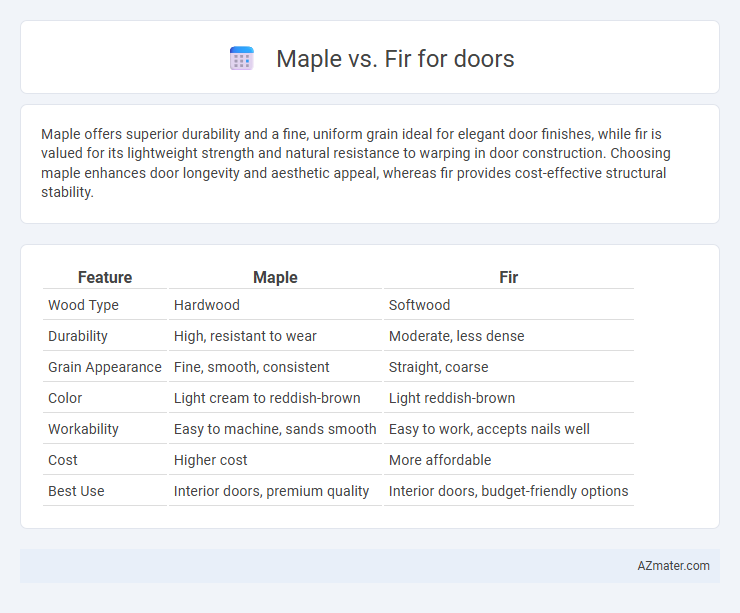Maple offers superior durability and a fine, uniform grain ideal for elegant door finishes, while fir is valued for its lightweight strength and natural resistance to warping in door construction. Choosing maple enhances door longevity and aesthetic appeal, whereas fir provides cost-effective structural stability.
Table of Comparison
| Feature | Maple | Fir |
|---|---|---|
| Wood Type | Hardwood | Softwood |
| Durability | High, resistant to wear | Moderate, less dense |
| Grain Appearance | Fine, smooth, consistent | Straight, coarse |
| Color | Light cream to reddish-brown | Light reddish-brown |
| Workability | Easy to machine, sands smooth | Easy to work, accepts nails well |
| Cost | Higher cost | More affordable |
| Best Use | Interior doors, premium quality | Interior doors, budget-friendly options |
Introduction to Maple and Fir Wood for Doors
Maple wood, known for its fine, consistent grain and exceptional hardness, offers excellent durability and resistance to wear, making it a popular choice for interior doors requiring a smooth, refined finish. Fir wood, characterized by straight grain and moderate strength, provides a lightweight yet sturdy option with good stability and resistance to warping, ideal for both interior and exterior doors in moderate climates. Both woods deliver reliable performance, but maple's density and hardness make it more suitable for high-traffic door applications, while fir's affordability and dimensional stability appeal to budget-conscious projects.
Key Characteristics of Maple Wood
Maple wood exhibits exceptional hardness and durability, making it ideal for door construction where resistance to dents and scratches is crucial. Its fine, uniform grain offers a smooth finish and excellent stability, reducing the likelihood of warping over time. Compared to fir, maple's dense structure enhances security and provides a sophisticated, elegant appearance favored in high-end doors.
Key Characteristics of Fir Wood
Fir wood, known for its straight grain and uniform texture, offers excellent strength and durability ideal for door construction. Its tight grain pattern provides a smooth finish that resists warping and shrinking, making it a stable choice in varying climates. Fir is also lightweight yet sturdy, enhancing ease of installation without compromising structural integrity.
Durability Comparison: Maple vs Fir
Maple doors offer superior durability compared to fir due to their dense grain structure, making them highly resistant to dents and scratches. Fir, while moderately durable, tends to be softer and more prone to wear over time, especially in high-traffic areas. For long-lasting door applications, maple provides enhanced strength and longevity, ideal for both interior and exterior use.
Aesthetic Appeal: Color and Grain Differences
Maple doors feature a light, creamy color with a subtle, consistent grain pattern that provides a smooth and contemporary aesthetic. Fir doors display a warm reddish-brown hue with prominent, straight grain lines, creating a rustic and textured appearance. Choosing between maple and fir depends on whether a clean, modern look or a natural, pronounced wood grain is preferred.
Cost Analysis: Maple vs Fir Doors
Maple doors typically cost more than fir doors due to the hardwood's density and durability, with prices averaging 20-30% higher per square foot. Fir doors offer a budget-friendly alternative, costing less while still providing decent strength and aesthetic appeal. Choosing between maple and fir for doors involves balancing initial investment against long-term wear and maintenance expenses.
Workability and Maintenance Needs
Maple offers excellent workability due to its smooth grain and hardness, making it ideal for precise door construction and fine detailing. Fir, being softer and more porous, is easier to cut and shape but may require extra care to avoid dents and scratches. Maintenance for maple doors involves less frequent refinishing due to its durability, while fir doors often need regular sealing and touch-ups to protect against moisture and wear.
Environmental Impact and Sustainability
Maple and fir differ significantly in environmental impact and sustainability, with maple being a slower-growing hardwood that takes more time to mature, potentially leading to higher ecological costs if not sourced responsibly. Fir, a fast-growing softwood, often comes from sustainably managed plantations, making it a more renewable option with lower carbon footprints in comparison. Choosing FSC-certified maple or fir ensures sustainable harvesting practices, preserving biodiversity and promoting reforestation efforts crucial for eco-friendly door materials.
Ideal Uses: When to Choose Maple or Fir
Maple doors offer superior hardness and durability, making them ideal for high-traffic areas such as entryways and commercial spaces where resistance to dents and scratches is essential. Fir doors provide a more affordable option with excellent dimensional stability, suitable for interior doors and environments requiring moderate strength and moisture resistance. Selecting maple is best for long-lasting, polished aesthetics, while fir is preferred for budget-conscious projects prioritizing easy staining and stability.
Conclusion: Which Wood is Best for Your Door?
Maple offers exceptional hardness and durability, making it ideal for doors that require strong resistance to dents and wear. Fir provides a more affordable option with a straight grain and moderate strength, suitable for doors where budget and ease of finishing are priorities. Choosing maple ensures long-lasting performance and a refined appearance, while fir suits projects leaning towards cost-effectiveness with acceptable durability.

Infographic: Maple vs Fir for Door
 azmater.com
azmater.com